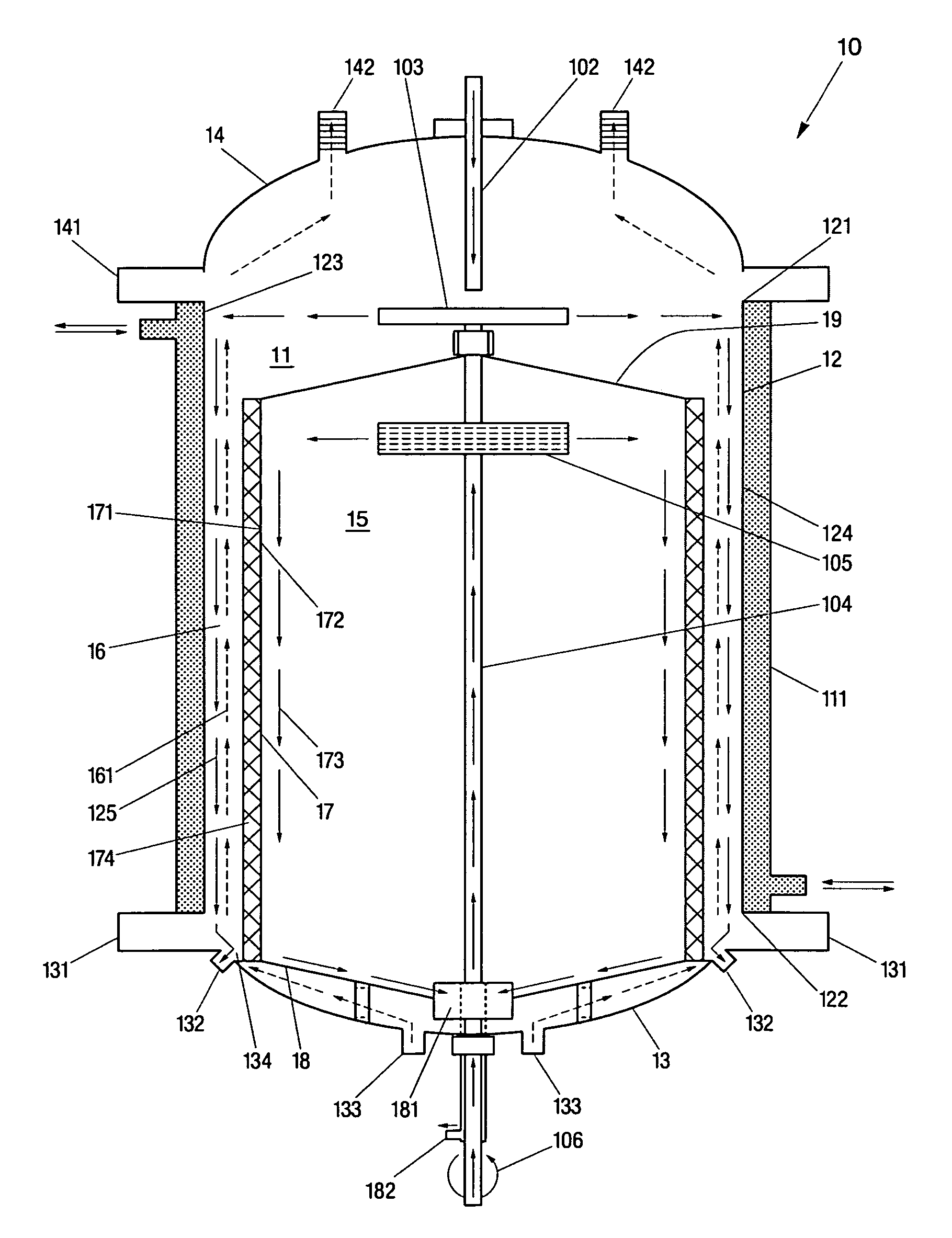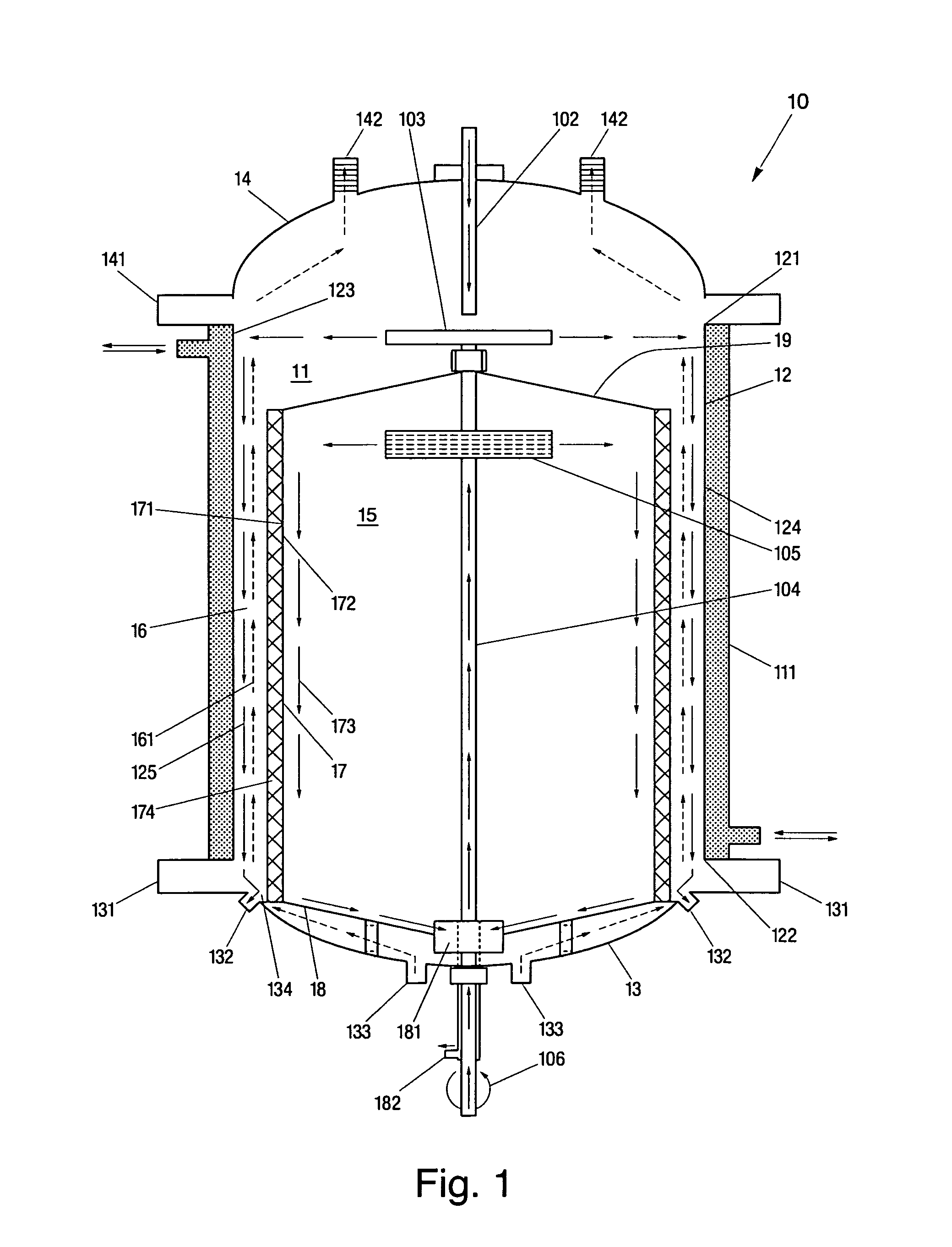Continuous processing reactors and methods of using same
a technology of continuous processing and reactors, which is applied in the direction of fluidised-bed furnaces, chemical/physical/physico-chemical stationary reactors, electrolysis, etc., can solve the problems of uneven material spread onto the inner wall of the treatment chamber, inability to achieve the proper hydrodynamics, and inability to achieve the effect of proper hydrodynamics, etc., to achieve the effect of high thermal transfer rate, and high thermal transfer ra
- Summary
- Abstract
- Description
- Claims
- Application Information
AI Technical Summary
Benefits of technology
Problems solved by technology
Method used
Image
Examples
example 1
Fluid-Fluid or Solid-Fluid-Fluid Reactions
[0060]As shown in the embodiments depicted in FIGS. 1, 2, 3 and 5 the reactor 10 of the present may be applicable for fluid-fluid or solid-fluid-fluid reactions in connection with organic systems. It should be appreciated that the term fluid as used herein and throughout this application includes, gas and liquid. Thus, reactor 10 may be applicable, for example, for gas-liquid, liquid-liquid, solid-gas-liquid reactions, or any other combination.
[0061]The reactor 10 illustrated in FIGS. 1, 2, and 3, in one embodiment, has particular application for organic systems where higher pressures and temperatures are used, for instance, hydrogenation, oxidation, polymerization, dealkylation, alkylation, methylation, carboxylation, decarboxylation, and Fisher-Tropps, among others. This application may further be useful in, for instance, the production of organic products from coal slurry or the production of dimethyl ether (DME) using either natural gas,...
example 2
[0066]As shown in the embodiment depicted in FIG. 5, reactor 50 of the present invention may be used in evaporation and distillation processes. Evaporation and distillation processes include, for instance, removing water from oil, ethanol, methanol, glycerine, or other compounds. In addition, such processes may include removing light organics from heavy organics, such as light sweet crude from heavy oil, methanol from biodiesel and glycerine mix, methanol from glycerine, and light organics from heavy oil. Furthermore, such processes may include removing organic solvents such as ethyl acetate from polymer dispersion or removing organic solvents or monomers during depolymerization processes. It may also be used in desalination of water, concentration of fruit juice, concentration of food materials, such as soup, milk, removal of light organics from ground water, removal of dissolved organics from processed water (i.e., industrial waste water), and removal o...
example 3
Deheating of Superheated Steam
[0073]In the embodiment depicted in FIG. 6, reactor 60 of the present invention may be used in connection with cooling of superheated steam, or desuperheating of steam. Both the inner surface 123 of outer vessel 11 and outer surface 171 of inner vessel 15 may be maintained at a temperature measurably lower (i.e., cooler) relative to the superheated steam.
[0074]To maintain the inner surface 123 of outer vessel 11 at a relatively cool temperature, a relatively cool liquid may be introduced through pathway 102 distributed by the first rotatable member 103 on to and substantially uniformly along the inner surface 123 of outer vessel 11. In addition or alternatively, jacket 111 may be set at a predetermined temperature level to keep the inner surface 123 at such a relatively cool temperature. To maintain the outer surface 171 of the inner vessel 15 at a similar relatively cool temperature, a relatively cool liquid may be introduced through tube 104 into inne...
PUM
| Property | Measurement | Unit |
|---|---|---|
| thickness | aaaaa | aaaaa |
| thickness | aaaaa | aaaaa |
| width | aaaaa | aaaaa |
Abstract
Description
Claims
Application Information
 Login to View More
Login to View More - R&D
- Intellectual Property
- Life Sciences
- Materials
- Tech Scout
- Unparalleled Data Quality
- Higher Quality Content
- 60% Fewer Hallucinations
Browse by: Latest US Patents, China's latest patents, Technical Efficacy Thesaurus, Application Domain, Technology Topic, Popular Technical Reports.
© 2025 PatSnap. All rights reserved.Legal|Privacy policy|Modern Slavery Act Transparency Statement|Sitemap|About US| Contact US: help@patsnap.com



